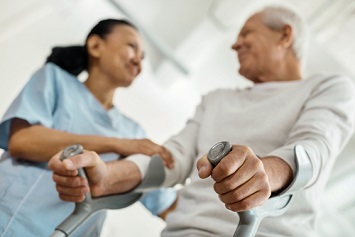On day 2 of Safety 2019, the annual conference of the American Society of Safety Professionals, taking place June 9–12 at the Ernest N. Morial Convention Center in New Orleans, Yeu-Li Yeung, the patient care ergonomics coordinator for Duke University Health System, and Neal Wiggermann, PhD, a specialist research scientist specializing in human factors and ergonomics for Hill-Rom, presented a session titled “Enhancing Safety for Patients and Employees When Handling and Mobilizing Patients: A Program Approach.”
During this session, which elicited significant audience engagement, Yeung and Wiggermann described the benefits of implementing a Safe Patient Handling and Mobility (SPHM) program for avoiding musculoskeletal injuries to healthcare workers and improving patient care and highlighted the essential elements needed to implement and sustain such a program.
Unique Ergonomic Hazards
Because of the significant hazards and challenges healthcare workers face when moving and mobilizing patients, they are at an increased risk of musculoskeletal disorders (MSDs) and injuries compared to workers in other industries. Patient handling risks arise frequently, including when transferring patients from their beds to chairs or the restroom, repositioning patients, transferring patients in diagnostic areas, and picking up patients who have fallen. Despite the recommended maximum safe weight limit for patient handling being 35 pounds, many facilities lack resources to help workers like nurses and nursing assistants with their patient handling tasks. That’s where the establishment of an SPHM program can help prevent healthcare worker injuries and improve patient care as a result.
What Is an SPHM Program?
An SPHM program is designed to identify and mitigate risk during patient handling, movement, and mobility tasks through use of safe patient handling practices, including use of appropriate technology, equipment, and techniques. The goal of these programs is to avoid high-risk patient handling tasks, whenever possible, with the exception of emergency situations. Though SPHM programs are required in 10 states, these regulations have not been broadly enforced. Consequently, it is up to individual healthcare organizations to adopt effective programs if they hope to reduce worker injuries, improve patient care, and reduce MSD-related costs.
Implementing an SPHM Program
Once a healthcare organization decides to adopt an SPHM program, how does it ensure successful adoption by its workforce? Yeung and Wiggermann recommended following the principles set forth by the American Nurses Association (ANA) in its Safe Patient Handling and Mobility standard. These elements include:
- Establishing a culture of safety;
- Implementing and sustaining an SPHM program;
- Selecting, installing, and maintaining SPHM technology, such as total-assist lifts with scales, ceiling-mounted lifts, powered sit/stand lifts, active standing aids, and walking aids;
- Integrating patient-centered assessment, care planning, and use of SPHM programs;
- Incorporating ergonomic design principles to provide a safe environment of care;
- Establishing a system for education, training, and maintaining competence;
- Utilizing available technology;
- Including SPHM programs in reasonable accommodation and postinjury return to work; and
- Establishing a comprehensive evaluation program.
Perhaps most critical of these elements is integrating patient-centered assessment, care planning, and use of SPHM programs. Because most healthcare professionals are more likely to follow SPHM program work practices if they recognize how these practices advance patient care rather than how the equipment will prevent injuries to themselves, a patient-centered approach is needed rather than an equipment-centered approach.

One way the Duke University Health System adopted this patient-centered approach in its SPHM program is by developing a mobility assessment tool for nurses. The tool empowers nurses to work with patients to assess their mobility by allowing them to ask patients to perform different levels of tasks. Based on whether or not the patient can successfully complete the task, the nurse will determine the patient’s level of mobility and integrate that information into his or her care plan. Using this information, the nurse and other healthcare workers can then choose the appropriate SPHM equipment for assisting the patient. This not only prevents ergonomic injuries and MSDs to employees but also enhances the level of patient care the organization is able to provide.
By following this approach in addition to the other ANA recommendations, SPHM programs have been shown to lead to a 50 percent reduction in healthcare worker injuries and a 75 percent reduction in lost workdays. Positive impacts on patients have been less significant, but these programs have been shown to result in shorter hospital stays and an increased likelihood of patients being able to move from their hospital beds on their own.
Persistent Pain Points
Despite the successes of SPHM programs in reducing healthcare workers’ ergonomic injuries due to patient handling activities, pain points still remain. While these programs have proven to be effective in the hospital setting, audience members were concerned about how they would translate to other healthcare settings, such as home health care, nursing homes, and emergency medical services, especially in the absence of expensive, bulky, state-of-the-art equipment. Yeung and Wiggermann also said there is work to be done in continuing to educate the C-suite on the importance of SPHM programs and implementing new ergonomic technologies. With that being said, SPHM programs remain the most effective solution for protecting healthcare workers from avoidable MSDs and ergonomic injuries while enhancing the level of care patients receive.

